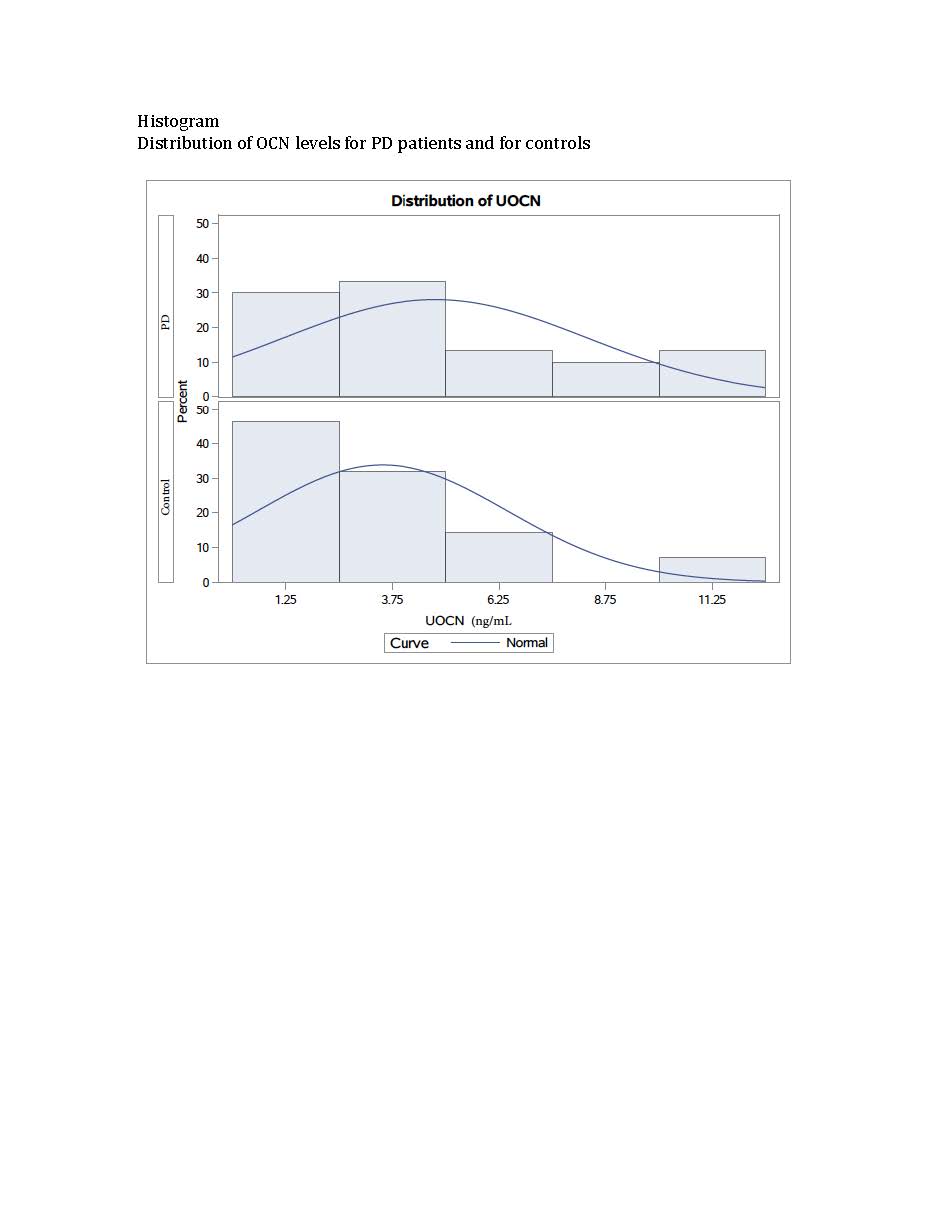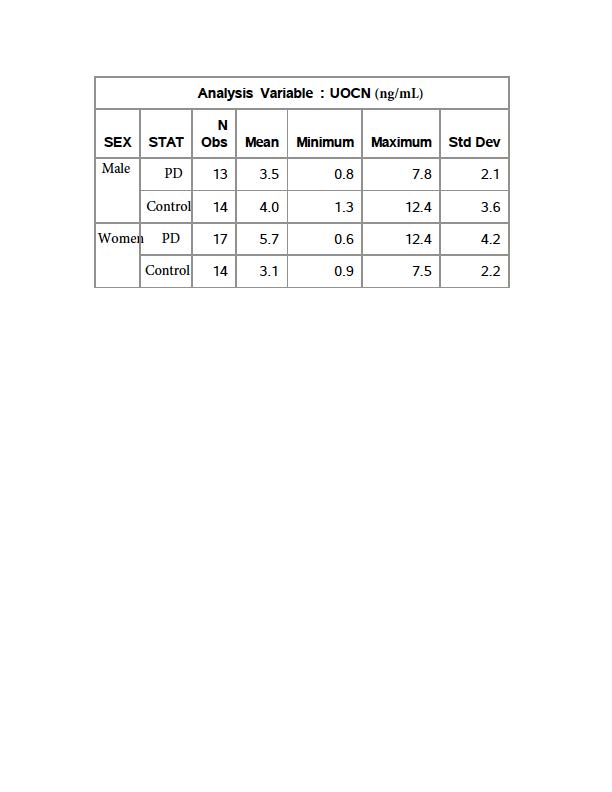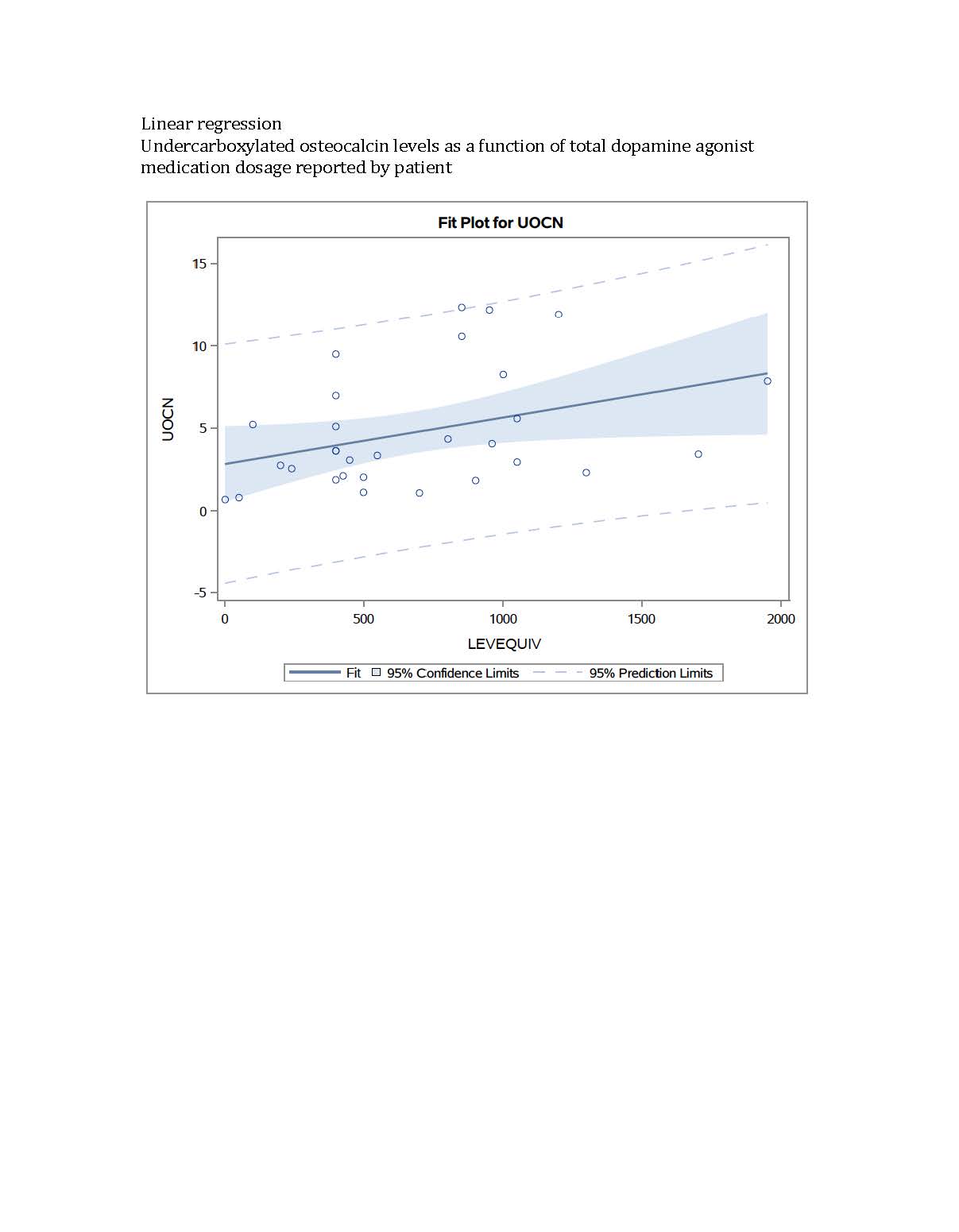Category: Parkinson's Disease: Pathophysiology
Objective: To characterize the relationship between the bone-derived hormone osteocalcin (OCN) and Parkinson’s disease (PD) in humans, and explore sex and treatment differences.
Background: The broad spectrum of functions of OCN in the brain and periphery suggests that bone is a master endocrine organ important for whole-body homeostasis (1). In mice, OCN is involved in dopaminergic neuronal development, binds to a dedicated receptor Gpr158 in midbrain and cortical neurons, promotes the production of all monoamine neurotransmitters, and favors cognition (1). Plasma injection of OCN partially restored behavioral deficits in a PD mouse model – potentially via anti-apoptotic effects on midbrain dopaminergic neurons, and inhibition of microglia and astrocytes (2). OCN peripheral injection in Ocn–null mice also restored the behavioral phenotype (3).
Method: We randomly selected 30 PD patients with Montreal Cognitive Assessment (MoCA) ≥27 and 30 normal age- and sex-matched controls with MoCA ≥25 from a PD cross-sectional study. We excluded carriers of genetic mutations associated with PD, and those with comorbidities (e.g., osteoporosis, renal failure, alcohol abuse) or medications (e.g. warfarin) known to interact with OCN. Plasma undercarboxylated OCN was measured using the Biolegend ELISA kit. Statistical analysis included a Wilcoxon rank sum test and a linear regression model.
Results: Mean OCN levels were 4.8ng/mL in PD and 3.5ng/mL in controls (p=0.13). 2 controls were indeterminate. In PD, OCN was 5.7 ± 4.2ng/mL in women vs. 3.5 ± 2.1ng/mL in men. Women with PD had on average 2.6ng/mL more OCN than controls, while men with PD had 0.43ng/mL less; the interaction term was marginally significant (p=0.06). OCN was not correlated with the UPDRS, duration of PD, age, or BMI. Dopamine agonist medication dose was positively correlated with OCN levels (B=0.0028, p=0.03).
Conclusion: OCN levels were not significantly different between PD and controls. However, there is initial evidence that sex is an effect modifier of OCN levels by disease status. Finally, given there are dopamine receptors on osteoblast and osteoclasts, it is interesting that dopamine agonist medications are significantly positively correlated with OCN levels (4). Together, these findings warrant further investigation of the relationship between OCN, sex differences, and PD treatment.
References: (1) Oury, F., et al. (2013). “Maternal and offspring pools of osteocalcin influence brain development and functions.” Cell 155(1): 228-241. (2) Guo, X. Z., Shan, C., Hou, Y. F., Zhu, G., Tao, B., Sun, L. H., Zhao, H. Y., Ning, G., Li, S. T., & Liu, J. M. (2018). Osteocalcin Ameliorates Motor Dysfunction in a 6-Hydroxydopamine-Induced Parkinson’s Disease Rat Model Through AKT/GSK3β Signaling. Frontiers in molecular neuroscience, 11, 343. (3) Obri, A., et al. (2018). “Osteocalcin in the brain: from embryonic development to age-related decline in cognition.” Nat Rev Endocrinol 14(3): 174-182. (4) Handa, K., Kiyohara, S., Yamakawa, T. et al. Bone loss caused by dopaminergic degeneration and levodopa treatment in Parkinson’s disease model mice. Sci Rep 9, 13768 (2019). This article found that levodopa suppresses the ability of bone formation by mature osteoblasts despite initially inducing differentiation of osteoblasts.
To cite this abstract in AMA style:
A.S Nordvig, R.N Alcalay, J.M Berger, K. Marder, G. Karsenty, A. Wang. Parkinson’s disease and osteocalcin pilot study: Is there a protective role of bone in neurodegeneration? [abstract]. Mov Disord. 2020; 35 (suppl 1). https://www.mdsabstracts.org/abstract/parkinsons-disease-and-osteocalcin-pilot-study-is-there-a-protective-role-of-bone-in-neurodegeneration/. Accessed December 14, 2025.« Back to MDS Virtual Congress 2020
MDS Abstracts - https://www.mdsabstracts.org/abstract/parkinsons-disease-and-osteocalcin-pilot-study-is-there-a-protective-role-of-bone-in-neurodegeneration/



